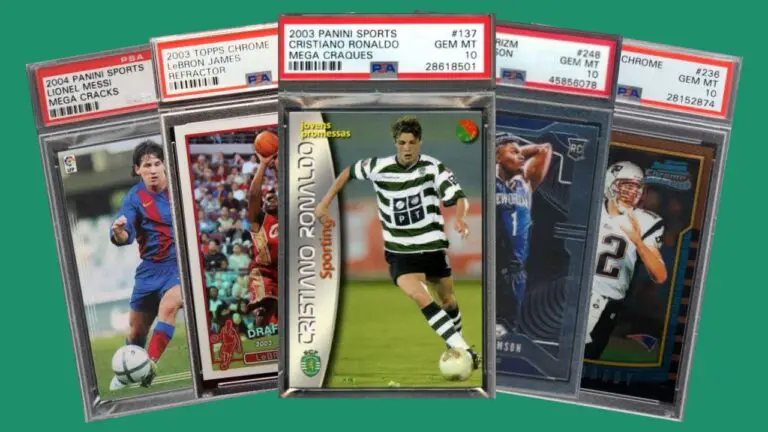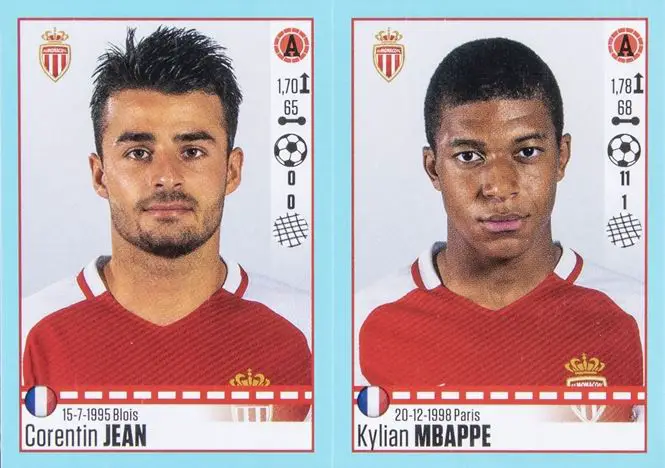
In the sports card hobby, a player’s rookie cards are often their most valuable cards.
In short, it’s mainly because of the appeal and mystique that surrounds a player’s first cards, that are usually released when they’re a regular, unestablished player.
Ultimately, the value of a card comes down to supply and demand. The more in-demand a card, the more it’s worth.
But there is more to know, and I’ve covered everything further down.
Table of Contents
Why Are Rookie Cards Usually More Valuable?
There’s Usually Less Supply Of A Rookie Card
A rookie card is released at the start of their career, when they’re normally largely unknown or unproven in their sport.
Although, these days hot prospects usually come with a lot of hype when they’re drafted or promoted to the senior team, so they have no shortage of rookie cards.
Think about it, Michael Jordan, Lionel Messi, Tom Brady for example… but before anyone knew what they’d achieve in their respective sports. They weren’t the global stars that they are today, so their rookie cards wouldn’t have been in such high demand like they would be now.
That means, at the time of release, there likely wasn’t a huge supply.
Then you have to also consider how little there must be in complete mint condition, to achieve a grading of 10, after all those years of them turning into some of the greatest to play the sport.
Again, as I mentioned earlier, value comes from the amount of supply and the amount of demand for that limited supply. The scarcity is created from the card being less produced because it’s not a hugely popular player at the time of release.
So, why are current rookie cards of players who are not fully established or still unproven also worth more?
Well that’s because collectors and investors now know that if a player hits the big time, then the card will shoot up in value, to crazy, life-changing, amounts of money in some cases.
It’s a sports card investment strategy that creates the demand, which drives the value up.
Collectors will buy based on speculation or the prediction that a player is going to be the next Michael Jordan, for example, and therefore they buy when the card still has room to become a lot more valuable in the future.
A good recent example of that is Kylian Mbappe in soccer, who many believe will reach the level of Lionel Messi and Cristiano Ronaldo by the time he reaches the end of his career.
There’s no denying he’s one of the top players in the world right now, but he has a way to go to be considered an all-time great. Mbappe’s rookie card (2016-17 Panini Foot Kylian Mbappe #505) was selling for over $20k, graded PSA 10, when he was just breaking through.

Collectors Love Older Cards
As with most collectables, age plays a big part in the value of something. Normally the older a collectable is, the more it’s perceived value.
It’s no different with sports cards, the phenomenon of owning a card that is older is something that has an appeal to collectors and investors.
Owning the card that’s issued only a year after the first just doesn’t have the same pull, even though they can still be desirable to own and go for big money.
The Mystique Of A Rookie Card
A player’s rookie card is their entry into the sports card hobby, and for a lot of collectors it’s almost like a badge of honor to own it.
It’s the equivalent of owning a base set 1st edition Pokemon card – the first issue has a huge appeal to collectors, and that plays a part in driving up the demand, which ultimately then drives up the price you have to pay.
For that reason, even in cases where the supply of a later issued card is lower than the supply of the true rookie card, the true rookie is usually worth more.
It’s a lot of fun for collectors to find and look at cards of a player years before they became a household name.
Are Rookie Cards Always More Valuable?
Rookie cards aren’t always a player’s most expensive sports cards, especially in the modern hobby.
That’s because a low-numbered card from a popular brand, for example, is first released later than their rookie season, and the demand, plus rarity outweighs the first-year cards.
In recent times, high-end limited and numbered cards, some with autographs and match-worn material patches, have become a bigger thing, and due to the real scarcity of them, they can become more valuable than the player’s rookies.
Generally, when you’re comparing like-for-like cards (like regular base cards), then the rookies are usually worth more.
What Is A Rookie Card?
The term ‘rookie card’ is what sports card collectors use to label a player’s first official cards, usually from their first professional season in the sport they play.
A rookie card is traditionally a base card from a first-year licenced product that is released by a mainstream card manufacturer – Anything else, like a first-year insert, is considered an XRC.
Players can have multiple different rookie cards.
Sometimes it can get a little confusing when players have cards labelled as rookie cards, but from different years.
Cristiano Ronaldo’s Sporting Lisbon rookie cards were released in 2002, For example the 2002-03 Panini Mega Craques card, but then he also has his international ‘rookie cards’, for Portugal, which were released in 2004, For example, the Panini Euro 2004 Sticker.
He also has his Manchester United ‘rookie cards’ (his first cards after transferring to that team) and so on.
A phrase you might have also come across is a ‘true rookie card’. A player’s true rookie is his very first official card, so staying with Ronaldo as an example, the true rookie card is the 2002-03 Panini Mega Craques, it’s the one that was released before all the others.

Final Thoughts
So, when you take into account the points I’ve discussed, it becomes clearer to see why rookie cards are generally worth more than others – the scarcity, the condition scarcity of older cards and the power that rookie cards hold in the eye of collectors.


